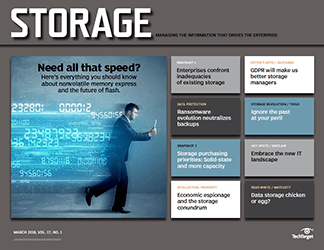PRO+ Premium Content/Storage
Access your Pro+ Content below.
NVMe SSDs: Is there a need for all this speed?

This article is part of the Storage issue of March 2018, Vol. 17, No. 1
For many years, SAS and SATA HDDs have been the data center's media of choice. The introduction of NAND flash has pushed SAS and SATA devices to their performance limits due to restrictions of the storage protocol. To fully exploit flash, the storage industry created a new protocol -- nonvolatile memory express. This architecture lets storage array vendors and end users unlock the performance potential of both flash and new solid-state media, delivering better performance from NVMe SSDs and other storage devices. Protocol background Storage device protocols have evolved in both server and consumer-based devices. Advanced Technology Attachment (ATA) developed from PC architecture, which became PATA (parallel ATA) and then SATA (Serial ATA) that we know today. SCSI was developed in the late 1970s as a server-based connection for HDDs and other storage devices like tape. All of this evolved into Serial-Attached SCSI, or SAS. SCSI is the underlying storage protocol for Fibre Channel-based SANs and iSCSI Ethernet networks. (We'll ...
Features in this issue
-
NVMe SSDs: Is there a need for all this speed?
Everything you should know to decide if nonvolatile memory express is right for your enterprise and, if it is, how to plan for the future of flash storage.
-
Primary storage optimization overcomes a range of challenges
Enterprises turn to different products, technologies and tools to optimize primary storage, overcome data storage challenges and make networked storage deployments more efficient.
-
Ten ways to protect intellectual property and trade secrets
Industrial espionage is on the rise, and more data means more risk. Find out how to control the growth of data stores and secure your organization's most valuable assets.
Columns in this issue
-
The EU's GDPR will make us better storage managers
The European Union's General Data Protection Regulation has organizations worldwide rethinking storage management to their and their customers' benefit.
-
The danger of ageism in the tech industry and ignoring the past
Monolithic storage rules the day in spite of the advent of software-defined storage, because vendors and enterprises ignore data storage history and discount experience.
-
Is demand for data storage or supply driving increased storage?
Figuring out whether we're storing more data than ever because we're producing more data or because constantly evolving storage technology lets us store more of it isn't easy.
